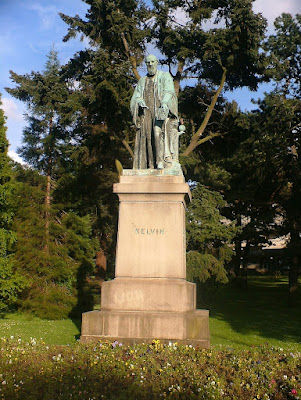The family of THOMSON, of whom we are about to treat, is of Scottish origin. In 1641, it is said that three
brothers, James, John and Robert Thomson, migrated from
the lowlands of Scotland, during the troubled times of the civil war.
JOHN THOMSON settled in County Down, at Ballymaglave,
and for nearly two centuries his descendants continued to occupy a
farm called Annaghmore, near Spa, Ballynahinch.
John Thomson's grandson,
JAMES THOMSON, had three sons: John, Robin and James Thomson (ca 1738-).
The first two sons, John and Robin, both migrated to Buffalo Valley, New York ca 1755.
On his house, on a quoin of a building now used as a barn, this James Thomson, grandson of John Thomson, cut his name, bearing the date 1707.The youngest son,
JAMES THOMSON, born about 1738, stayed in Scotland, and married, in 1768, Agnes Nesbitt, who bore him three sons: Robert, John and James Thomson (mathematician).
At this period the Thomsons owned about one quarter of the townland of Ballymaglave.
JAMES THOMSON (1786-1849), of Annaghmore, near Ballynahinch, County Down, was a teacher of mathematics and engineering at Royal Belfast Academical Institution (Inst).
Although originally Scottish, the family were Presbyterians who had been forced to leave Ayrshire in the 1640s during the struggle between the episcopacy of CHARLES I and the Covenanters. They settled in Ulster. James Thomson's father, also called James, was a farmer.
He married Margaret Gardner in 1817 and, of their children, four boys and two girls survived infancy.
Margaret Thomson died in 1830 when their son William was only six years old.
WILLIAM THOMSON was born at 17, College Square East, Belfast, on the 26th June, 1824.
 |
| College Square East, Belfast |
In 1832, his father was appointed professor of mathematics at Glasgow and the family relocated there in October, 1833.
The Thomson children were introduced to a broader cosmopolitan experience than their father's rural upbringing, spending the summer of 1839 in London; the boys were tutored in French, in Paris.
The summer of 1840 was spent in Germany and the Netherlands. Language study was given a high priority.
William Thomson was educated at Glasgow University from the age of eleven and at Peterhouse, Cambridge.
In 1846 he became Professor of Natural Philosophy at Glasgow, a post which he held for fifty-three years.
In 1852 he married Margaret, daughter of Walter Crum of Thornliebank, who died in 1870; and in 1874 he married Frances Anna, daughter of Charles R Blandy, of Madeira.
In 1852 he married Margaret, daughter of Walter Crum of Thornliebank, who died in 1870; and in 1874 he married Frances Anna, daughter of Charles R Blandy, of Madeira.
He discovered the second law of thermodynamics, but also carried out considerable research on electric currents which was to prove invaluable in submarine telegraphy and accounted for the success of the Atlantic cables.
 |
| Kelvin Memorial Window at Westminster Abbey |
He also devised a more accurate way of determining the size of the earth.
He invented depth-sounding apparatus, tide gauges, a new type of ship's compass, and instruments for measuring electricity.
In 1866 he was granted a knighthood.
Sir William was elevated to the peerage, in 1892, in the dignity of BARON KELVIN, of Largs, Ayrshire.
In 1896, Lord Kelvin was appointed Knight Grand Cross of the Royal Victorian Order; and in 1902 he received the Order of Merit, thus becoming the Rt Hon the Lord Kelvin OM GCVO PC.
Sir William was elevated to the peerage, in 1892, in the dignity of BARON KELVIN, of Largs, Ayrshire.
In 1896, Lord Kelvin was appointed Knight Grand Cross of the Royal Victorian Order; and in 1902 he received the Order of Merit, thus becoming the Rt Hon the Lord Kelvin OM GCVO PC.
An exhibition of his inventions in 1896 attended by prominent international scientists was held as part of his fifty years' service as professor.
He wrote prolifically and his works are collected as Mathematical and Physical Papers.
He wrote prolifically and his works are collected as Mathematical and Physical Papers.
Lord Kelvin died in Scotland on the 17th December, 1907, and is buried in Westminster Abbey.
The Kelvin temperature scale is a memorial to his name.
Lord Kelvin's statue stands at the entrance to Botanic Gardens, Belfast.
The Kelvin temperature scale is a memorial to his name.
Lord Kelvin was an Elder of St Columba's Parish Church, Largs, for many years.
It was to that church that his remains were taken after his death in 1907.
It was to that church that his remains were taken after his death in 1907.
Lord Kelvin died without issue, when the title expired.
First published in May, 2011.





4 comments :
when the father of the great Lord Kelvin was 12, in 1798, he was an eye-witness to the Battle of Ballynahinch, when Crown forces defeated the United Irishmen.
"In 1641, it is said that three brothers, James, John and Robert Thomson, migrated from the lowlands of Scotland, during the troubled times of the civil war."
has anyone managed to trace any descendants of the other 2 brothers?
I'm also on the trail, my Father's grandfathers obit states that William Lord Kelvin was his cousin. I'm going on the basis this must follow a line from either John or Robert - Kelvin's paternal uncles. I'm finding nada though in terms of how the line got from Scotland to here in New Zealand. Anyways, assuming this mythology is right, the family line sure spread far and wide, but alas the mathematical genius didn't extend so far.
It is good to see Kelvin without a dustbin adorning his head, usually put there by a waggish student!
Post a Comment